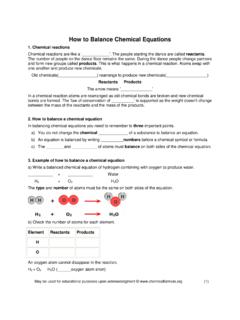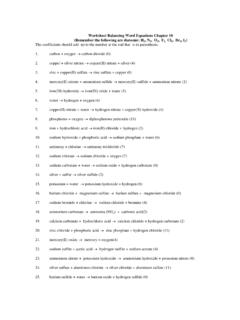Transcription of 4.1Writing and Balancing Chemical Equations
1 Writing and Balancing Chemical EquationsBy the end of this section, you will be able to: Derive Chemical Equations from narrative descriptions of Chemical reactions. Write and balance Chemical Equations in molecular, total ionic, and net ionic to yield ions, or combine with other atoms to form molecules, their symbols are modified or combined and the relative quantities of substances undergoing a Chemical (or physical) change involves writing andbalancingachemical (CH4)andtwodiatomicoxygenmolecules(O2)to produceonecarbondioxidemolecule(CO2)andt wowatermolecules(H2O).Thechemicalequatio nrepresentingthisprocessisprovidedintheu pperhalfofFigure ,withspace-fillingmolecularmodels shown in the lower half of the reaction between methane and oxygen to yield carbon dioxide in water (shown at bottom) may berepresented by a Chemical equation using formulas (top).
2 This example illustrates the fundamental aspects of any Chemical , ,andtheirformulasareplacedontherightsigh tof the signs (+) separate individual reactant and product formulas, and an arrow( )separates the reactantand product (left and right) sides of the relative numbers of reactant and product species are represented bycoefficients(numbers placedimmediately to the left of each formula). A coefficient of 1 is typically is common practice to use the smallest possible whole-number coefficients in a Chemical equation, as is done , however,thatthesecoefficientsrepresentth erelativenumbersofreactantsandproducts,a nd,therefore, they may be correctly interpreted as ratios. Methane and oxygen react to yield carbon dioxide and waterin a 1:2:1:2 ratio. This ratio is satisfied if the numbers of these molecules are, respectively, 1-2-1-2, or 2-4-2-4, or3-6-3-6,andsoon(Figure ).
3 Likewise,thesecoefficientsmaybeinterpret edwithregardtoanyamount(number)unit, and so this equation may be correctly read in many ways, including:176 Chapter 4 Stoichiometry of Chemical ReactionsThis content is available for free at Onemethane molecule andtwooxygen molecules react to yieldonecarbon dioxide molecule andtwowatermolecules. One dozenmethane molecules andtwo dozenoxygen molecules react to yieldone dozencarbon dioxidemolecules andtwo dozenwater molecules. One moleof methane molecules and2 molesof oxygen molecules react to yield1 moleof carbon dioxidemolecules and2 molesof water of the absolute number of molecules involved, the ratios between numbers of molecules arethe same as that given in the Chemical EquationsThe Chemical equation described in section isbalanced, meaning that equal numbers of atoms for each elementinvolved in the reaction are represented on the reactant and product sides.
4 This is a requirement the equation atoms on either side of the arrow and comparing these sums to ensure they are equal. Note that the number ofatoms for a given element is calculated by multiplying the coefficient of any formula containing that element by theelement , ,bothproductspeciesintheexamplereaction, CO2andH2O,containtheelementoxygen,andsot henumberofoxygenatomsontheproductside of the equation is 1 CO2molecule 2 O atomsCO2molecule + 2 H2O molecule 1 O atomH2O molecule = 4 O atomsThe equation for the reaction between methane and oxygen to yield carbon dioxide and water is confirmed to bebalanced per this approach, as shown here:CH4+ 2O2 CO2+ 2H2 OElement ReactantsProductsBalanced?C1 1 = 11 1 = 11 = 1, yesH4 1 = 42 2 = 44 = 4, yesO2 2 = 4 (1 2) + (2 1) = 4 4 = 4, yesChapter 4 Stoichiometry of Chemical Reactions177A balanced Chemical equation often may be derived from a qualitative description of some Chemical reaction by hydrogen and oxygen.
5 This process is represented qualitatively by anunbalancedchemical equation:H2O H2+ O2(unbalanced)Comparing the number of H and O atoms on either side of this equation confirms its imbalance:Element Reactants Products Balanced?H1 2 = 2 1 2 = 2 2 = 2, yesO1 1 = 1 1 2 = 2 1 2, noThe numbers of H atoms on the reactant and product sides of the equation are equal, but the numbers of O , ,ofcourse,thattheformula subscriptsdefine, in part, the identity of the substance, and so these cannot be changed without ,changingthereactantformulafromH2 OtoH2O2wouldyieldbalanceinthenumberofato ms,butdoingsoalsochangesthereactant sidentity(it snowhydrogenperoxideandnotwater). The O atom balance may be achieved by changing the coefficient for H2O to H2+ O2(unbalanced)Element Reactants Products Balanced?
6 H2 2 = 4 1 2 = 2 4 2, noO2 1 = 2 1 2 = 2 2 = 2, yesThe H atom balance was upset by this change, but it is easily reestablished by changing the coefficient for the H2product to 2H2+ O2(balanced)Element Reactants Products Balanced?H2 2 = 42 2 = 2 4 = 4, yesO2 1 = 2 1 2 = 2 2 = 2, yesThese coefficients yield equal numbers of both H and O atoms on the reactant and product sides, and the balancedequation is, therefore:2H2O 2H2+ O2 Example Chemical Equations178 Chapter 4 Stoichiometry of Chemical ReactionsThis content is available for free at a balanced equation for the reaction of molecular nitrogen (N2) and oxygen (O2) to form , write the unbalanced + O2 N2O5(unbalanced)Next, count the number of each type of atom present in the unbalanced Reactants Products Balanced?
7 N1 2 = 2 1 2 = 2 2 = 2, yesO1 2 = 2 1 5 = 5 2 5, noThoughnitrogenisbalanced, ,areasonablefirstattemptwouldbetochanget hecoefficientsfortheO2andN2O5tointegerst hatwillyield10 Oatoms(theleastcommonmultiplefortheOatom subscriptsinthese two formulas).N2+5O2 2N2O5(unbalanced)Element Reactants Products Balanced?N1 2 = 22 2 = 42 4, noO5 2 = 102 5 = 10 10 = 10, yesTheNatombalancehasbeenupsetbythischan ge;itisrestoredbychangingthecoefficientf orthereactantN2to + 5O2 2N2O5 Element Reactants Products Balanced?N2 2 = 4 2 2 = 4 4 = 4, yesO5 2 = 10 2 5 = 10 10 = 10, yesThenumbersofNandOatomsoneithersideoft heequationarenowequal, Your LearningWrite a balanced equation for the decomposition of ammonium nitrate to form molecular nitrogen,molecular oxygen, and water.
8 (Hint: Balance oxygen last, since it is present in more than one molecule onthe right side of the equation.)Answer:2NH4NO3 2N2+O2+ 4 H2 OChapter 4 Stoichiometry of Chemical Reactions179 Itissometimesconvenienttousefractionsins teadofintegersasintermediatecoefficients intheprocessofbalancinga Chemical equation. When balance is achieved, all the equation s coefficients may then be multiplied by a wholenumber to convert the fractional coefficients to integers without upsetting the atom balance. For example, considerthe reaction of ethane (C2H6) with oxygen to yield H2O and CO2, represented by the unbalanced equation:C2H6+ O2 H2O + CO2(unbalanced)Followingtheusualinspecti onapproach,onemightfirstbalanceCandHatom sbychangingthecoefficientsforthetwo product species, as shown:C2H6+ O2 3H2O + 2CO2(unbalanced)ThisresultsinsevenOatoms ontheproductsideoftheequation,anoddnumbe r nointegercoefficientcanbeusedwith the O2reactant to yield an odd number, so a fractional coefficient,72,is used instead to yield a provisionalbalanced equation:C2H6+72O2 3H2O + 2CO2A conventional balanced equation with integer-only coefficients is derived by multiplying each coefficient by 2.
9 2C2H6+ 7O2 6H2O + 4CO2 Finally with regard to balanced Equations , recall that convention dictates use of thesmallest whole-numbercoefficients. Although the equation for the reaction between molecular nitrogen and molecular hydrogen to produceammonia is, indeed, balanced,3N2+ 9H2 6NH3the coefficients are not the smallest possible integers representing the relative numbers of reactant and productmolecules. Dividing each coefficient by the greatest common factor, 3, gives the preferred equation:N2+ 3H2 2NH3 Use this interactivetutorial ( )foradditional practice Balancing Information in Chemical EquationsThe physical states of reactants and products in Chemical Equations very often are indicated with a parentheticalabbreviation following the formulas. Common abbreviations includesfor solids,lfor liquids,gfor gases, andaqfor substances dissolved in water (aqueous solutions, as introduced in the preceding chapter).
10 These notations areillustrated in the example equation here:2Na(s) + 2H2O(l) 2 NaOH(aq) + H2(g) (asolidinpureform,but readily dissolved in water).Link to Learning180 Chapter 4 Stoichiometry of Chemical ReactionsThis content is available for free at ,areactioncarriedoutbyheatingmaybeindica tedbytheuppercaseGreekletterdelta( ) over the (s) CaO(s) + CO2(g)Other examples of these special conditions will be encountered in more depth in later for Ionic ReactionsGiventheabundanceofwateronearth , ,thechemicalequationsmaybewrittenwithvar iouslevelsofdetailappropriate to their intended use. To illustrate this, consider a reaction between ionic compounds taking place in ,areactiontakesplaceproducingaqueousCa(N O3)2and solid AgCl:CaCl2(aq) + 2 AgNO3(aq) Ca(NO3)2(aq)+ 2 AgCl(s)This balanced equation, derived in the usual fashion, is called amolecular equationbecause it doesn t ,theymaydissociateinto their constituent ions, which are subsequently dispersed homogenously throughout the resulting solution (athoroughdiscussionofthisimportantproce ssisprovidedinthechapteronsolutions).
















